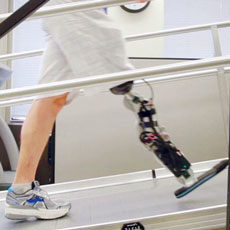
Nursing home residents with an amputated leg might soon gain new walking independence, thanks to a motorcycle accident victim and researchers at the Rehabilitation Institute of Chicago.
RIC doctors recently unveiled an artificial leg that is controlled by the user’s thoughts. Experts say this innovation delivers a dramatic improvement over traditional prosthetic legs, making it easier for users to get around.
Zac Vawter, the nation’s first person to have a so-called bionic leg, lost his right leg above the knee in a 2009 motorcycle accident.
“The bionic leg responds quickly and more appropriately, allowing me to interact with my environment in a way that is similar to how I moved before my amputation,” he explained.
He added that he can now walk up and down stairs and even reposition the prosthetic by thinking about the movement he wants to perform.
Two nerves in his legs were rewired to his hamstring muscle to help make the leg work. That was an important adaptation, as the nerves communicate with sensors in the prosthetic leg socket. They send a message to a computer, which basically tells leg muscles to help out.
“So when he thinks about straightening or bending his knee, this computer can detect that and tell the knee to bend or to straighten,” said Annie Simon, Ph.D., a biomedical engineer at the institute.
Levi Hargrove, Ph.D., directed a team that spent four years developing the new leg Vawter is using.
Hargrove noted that the challenge with prosthetic legs goes beyond walking on level ground. Patients must be able to go from sitting to standing as well as walk up stairs and ramps.
“We’re making rapid progress,” Hargrove said.
Funding for the project arrived through an $8 million grant from the U.S. Army. Full findings appear in the New England Journal of Medicine.
From the November 01, 2013 Issue of McKnight's Long-Term Care News




